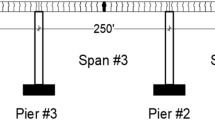Abstract
The health of concrete structures is important because collapse of these structures can cause damage for humans. This paper presents an analytical model for calculation of crack widths in structural concrete members using Internet of Things. The model is mathematically derived from the actual bond stress-slip relationship between the reinforcing steel and the surrounding concrete. The relationships summarized in CEB-FIP Model Code 1990 and Eurocode 2 are used in this study together with the numerical analysis result of a linear slip distribution along the interface at the stabilized cracking stage. With these, the actual strains of the steel and the concrete are integrated respectively along the embedment length between the adjacent cracks to obtain the difference in the axial elongation. This model is applied to the test results available in literature. The predicted values are shown to be in agreement with the experimentally measured data.











Similar content being viewed by others
References
ACI Committee 318 (1995) Building code requirements for structural concrete and commentary (ACI 318–95). ACI, Farmington Hill
Annette BR (2012) Analytical and numerical modeling of reinforced concrete in serviceability limit state. Master’s Thesis, Aarhus University
Argyros IK, George S (2015) Ball convergence for Steffensen-type fourth-order methods. Int J Interact Multimed Artif Intell 3(4):37–42. doi:10.9781/ijimai.2015.347
Argyros IK, González D (2015) Local convergence for an improved Jarratt-type method in Banach space. Int J Interact Multimed Artif Intell 3(4):20–25. doi:10.9781/ijimai.2015.344
Argyros IK, Magreñán ÁA (2016) A study on the local convergence and the dynamics of Chebyshev–Halley-type methods free from second derivative. Numer Algorithms 71(1):1–23. doi:10.1007/s11075-015-9981-x
Balazs G (1993) Cracking analysis bases on slip and bond stresses. ACI Mater J 90(4):340–348. doi:10.14359/3890
Bilal SH, Mohamad HH (2001) Effect of fiber reinforcement on bond strength of tension lap splices in high-strength concrete. ACI Struct J 98(5):638–647. doi:10.14359/10617
CEB-FIP (1991) CEB-FIP model code 1990. Comite Euro International Du Beton, Paris
Chan HC, Cheung YK, Huang YP (1992) Crack analysis of reinforced concrete tension members. ASCE J Struct Eng 118(8):2118–2131. doi:10.1061/(asce)0733-9445(1992)118:8(2118)
Dimosthenis F (2013) Modeling and simulation of reinforced concrete beams coupled analysis of imperfectly bonded reinforcement in fracturing concrete. Master’s Thesis, Chalmers University of Technology, Goteborg
European Committee for Standardization (2002) Eurocode 2-Design of concrete structures. European Committee for Standardization, Brussels
Fib (1999) Structural concrete-volume 2. International Federation for Structural Concrete, Switzerland
Fib Task Group (2000) Bond of reinforcement in concrete. International Federation for Structural Concrete, Switzerland
Gergely P, Lutz LA (1968) Maximum crack width in reinforced concrete flexural members. ACI, Michigan
Gilbert RI (2008) Control of flexural cracking in reinforced concrete. ACI Struct J 105(3):301–307. doi:10.14359/19789
Jiang, DH, Shah SP, Andonian AT (1984) Study of the transfer of tensile force by bond. ACI J 81(3):251–259. doi:10.14359/10681
Jin J, Gubbi J, Marusic S, Palaniswami M (2014) An information framework for creating a smart city through internet of things. IEEE Internet Things J 1(2):112–121. doi:10.1109/JIOT.2013.2296516
Kang YJ, Oh BH (1985) Determination of crack width and crack spacing in reinforced concrete flexural members. KSCE J 5(4):103–111
Ko WJ, Park SK (2002) Estimation of flexural crack width considering bonding characteristics in concrete members. KSCE J 22(4–A):825–835
Magreñán AA (2014) Different anomalies in a Jarratt family of iterative root-finding methods. Appl Math Comput 233:29–38. doi:10.1016/j.amc.2014.01.037
Maity S, Park JH (2016) Powering IoT devices : a novel design and analysis technique. J Converg 7(2):1–18
Mirza MS, Houde J (1979) Study of bond stress–slip relationships in reinforced concrete. ACI J 76(1):19–46. doi:10.14359/6935
Nawy EG (1968) Crack control in reinforced concrete structures. ACI J 65(10):825–836. doi:10.14359/7515
Noh SY, Krätzig WB, Meskouris K (2003) Numerical simulation of serviceability, damage evolution and failure of reinforced concrete shells. Comput Struct 81(5):843–857. doi:10.1016/s0045-7949(03)00164-0
Sato A, Huang R, Yen NY (2015) Design of fusion technique-based mining engine for smart business. Human-Centric Comput Inf Sci 2015(5):1–16. doi:10.1186/s13673-015-0036-z
Shunsheng Y, Jiakui C (1988) Bond slip and crack width calculations of tension members. ACI J 85(4):414–422. doi:10.14359/2693
Acknowledgements
This research was supported by the MSIP (Ministry of Science, ICT and Future Planning), Korea, under the ITRC (Information Technology Research Center) support program (IITP 2017-2015-0-00403) supervised by the IITP (Institute for Information and communications Technology Promotion) and by the Soonchunhyang University Research Fund.
Author information
Authors and Affiliations
Corresponding author
Ethics declarations
Conflict of interest
The authors declare that there is no conflict of interests regarding the publication of this paper.
Ethical approval
This article does not contain any studies with human participants or animals performed by any of the authors.
Rights and permissions
About this article
Cite this article
Lee, K., Lee, H. Numerical analysis and modeling for crack width calculation using IoT in reinforced concrete members. J Ambient Intell Human Comput 9, 1119–1130 (2018). https://doi.org/10.1007/s12652-017-0543-z
Received:
Accepted:
Published:
Issue Date:
DOI: https://doi.org/10.1007/s12652-017-0543-z




